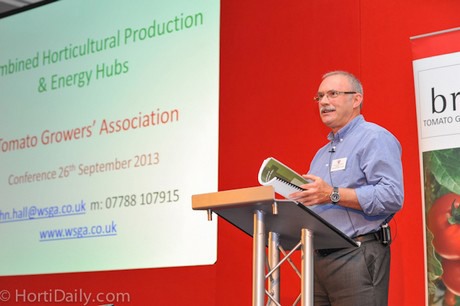“A combined horticultural production and energy hub is a closed system that works like a virtuous circle,” explained Hall. “Everything from waste material, gas, combined heat, power plants and carbon dioxide to horticultural production is considered; the cycle goes round and round forever.” The system considers all inputs and outputs to reduce waste and maximize resources during horticultural production while also generating energy that can be put back into the energy grid. The potential benefits of such a system are enormous to the horticultural industry in West Sussex, where horticulture brings in half a million pounds in retail sales every year. But Hall noted that many new projects have encountered opposition in the past.

“There have been problems with local planning commissions to extend nurseries, build glasshouses or supply the infrastructure necessary for horticultural projects,” said Hall. “We've had a few big cases where industry lost appeals regarding planning applications, so the thinking is that it's time we explain these projects to local authorities and others involved in the production of food and other crops.” That includes funding research into the benefits of combined horticultural and energy hubs and sharing that research with planning commissions and the public at large.
“It's about meeting the needs of customers, because customer demand for our products is more than we can supply, so it's not just about making these projects as efficient as possible, but about making them attractive to the authorities and the public,” said Hall. “If you go to authorities and say you want to build something, you'll likely get a negative response. But if you explain how a broader program, one with combined energy hubs and community heating schemes, is beneficial, you get a completely different reaction.” The benefits include food security, energy security and efficiency, waste management, extra power to the national grid and the socioeconomic benefits of more jobs. The benefits are numerous, and Hall thinks it's a matter of getting all stakeholders involved and keeping plans as flexible as possible so they come to fruition.
“The most successful hubs are those where there's interdependence between horticultural production and energy production,” said Hall. “Because it's sustainable, it ticks a lot of boxes, provides a diversity of new crops and technologies and makes large scale expansion more feasible, and all those things make it easier to discuss these projects with local authorities.
In order to help UK growers to kick start new business strategies, Hall and his group developed three models how such hubs can be structured:
- Green model: Glasshouse development owned by growers + joint venture for energy company
- Blue model: Glasshouse development by growers + energy from waste
- Purple model: Land owner + Institutional investor + growers+ Joint venture for infrastructure and energy hub.
All of the models are based on a certain acreage of glass and show variations in socio-economic benefits and annual turnover. For example a hub with 40 hectares of glass houses can provide 1,000 jobs and over 47 million euro of sales in fresh produce. It can save 25,000 tonnes of CO2 per annum and energy for 6,000 homes. There will be food and plant security and of course import substitution. "These kind of projects have proved to be very sufficient already in the Netherlands, where greenhouses are now more welcomed by the public because they can provide more than just a bunch of tomatoes; energy and jobs."
Hall's models come at the right time, as the retailers in the UK announced plans to double the amount of UK grown produce and glasshouse growers therefore look to expand. Hopefully the UK growers can adapt Hall's model in their strategy and will the public no longer go BANANAs on the subject.
For more information:
John Hall : http://www.linkedin.com/pub/john-hall/19/740/3bb
